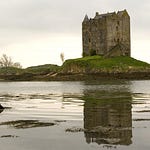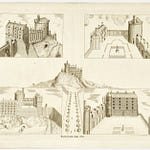Welcome back to "A Scottish Castle, A Day," brought to you by bagtownclans.com. I’m your host, Colin MacDonald, and today we journey to the beautiful lowlands of Renfrewshire, where we’ll explore the storied past of Barr Castle. Nestled just south of the village of Lochwinnoch, Barr Castle stands as a testament to Scotland’s rich medieval heritage. Though now a ruin, this late medieval tower house has weathered the centuries, and its history is interwoven with some of Scotland's most notable families, such as the Glens, Hamiltons, and MacDowalls. As we dig deeper, you'll discover not only the architectural wonders of this 15th or early 16th-century fortress but also its remarkable connection to local history, especially in Renfrewshire.
The first thing visitors notice about Barr Castle is its striking simplicity. The rectangular tower, measuring about 7.8 meters by 10.7 meters, rises to an impressive height of around 12 meters, even without its original four angle turrets, which have long since vanished. While it might lack the grand ornamentation seen in other Scottish castles, Barr Castle’s imposing presence comes from its solid mass, standing proudly on a low ridge amidst a well-wooded park. The castle’s rough square-faced masonry walls are characteristic of the time, and the sharp, dressed stone corner quoins give the structure an austere elegance.
Though Barr Castle's architecture may seem plain to some, it holds subtle, telling details. One of the few remaining decorative features is the pediment above the main entrance, inscribed with the initials of Margaret Hamilton and John Wallace, the Hamilton lairds who once called this tower home. These inscriptions, along with others scattered around the castle walls, offer clues to the castle’s later alterations during the 17th century when it was adapted into a more comfortable residence.
Barr Castle’s early history is rooted in the Glen family, an ancient and noble line in Renfrewshire. The Glens were recorded as early as the mid-15th century when Allanus Glen, a key figure in the family, is mentioned in documents related to a donation of fishing rights to the Monks of Paisley in 1452. By 1506, James Glen, another member of the family, had obtained lands from the Abbot of Paisley, including Barr, Bridge-end, and Lyntchels. This connection to the Glen family continued until the early 17th century when the family line ended with Alexander Glen’s death in 1629.
With the death of Alexander Glen, Barr Castle passed to the Hamiltons of Ferguslie, a powerful branch of the Hamilton family. One particularly intriguing story from this time involves James Glen of Barr, who was caught up in the politics of Queen Mary and Regent Moray’s time. James fought on Queen Mary’s side at the Battle of Langside in 1568 and was subsequently forfeited by the victorious Regent. However, his lands and titles were later restored by the Treaty of Perth in 1573.
When Barr Castle transitioned into the Hamilton family, it continued to be a place of local prominence. The Hamiltons made several changes to the castle, including the additions of dated inscriptions, like the one reading "IW" and "MH" over the main entrance, indicating John Wallace and his wife Margaret Hamilton. These are remnants of the family's presence that can still be seen today.
Barr Castle’s layout reflects both its original defensive function and later adaptation as a more comfortable home. Entering the castle today, visitors would pass through the west-facing entrance, though this was a later alteration. The original doorway, more typical of tower houses, was located on the first floor and accessed by a stairway—this design element helped defend the castle during an attack.
Inside, the ground floor once contained two vaulted rooms, each with its own purpose. The kitchen boasted a large, low-arched fireplace, a necessity for a family of the Hamiltons' standing. Above, the first floor housed a grand hall, which, unlike the high, arching halls of other Scottish castles, had a flat ceiling. This hall would have been the center of social life, where meals were shared, guests entertained, and important matters of local governance discussed.
Further up, the second and third floors were divided into private apartments, with each room having its own garderobe—essentially a medieval bathroom. These rooms were accessed by two separate staircases, indicating a degree of privacy for the residents. The battlements, once a crucial part of the tower's defense, featured corner turrets and a complete passageway along the top of the tower. Although these elements have long disappeared, remnants of their structure can still be traced in the stonework.
As part of the broader landscape of Lochwinnoch, Barr Castle is more than just a ruin—it’s a window into the life of the local community in centuries past. The nearby lands, detailed in the Poll Tax Roll of 1695, were home to farms like Sunnyaykers, Johnshill, and Bridgend. These settlements, along with the lands of Barr itself, were essential to the economy and daily life surrounding the castle. It wasn’t just a place of residence for the laird; it was a focal point for the agricultural and social life of the region.
The Hamilton family’s connection to Barr Castle lasted until the late 18th century when they abandoned the tower for a more modern mansion. In the years that followed, the castle fell into disrepair, though its robust structure ensured that much of it survived the centuries. Today, Barr Castle is a scheduled monument, protected for its historical significance, though it now belongs to the MacDowall family, whose chief, Fergus MacDowall of Garthland, serves as the current owner and custodian of the site.
Barr Castle may no longer be the seat of a noble family or a bustling center of medieval life, but its ruins continue to stand as a reminder of Scotland's turbulent and fascinating history. The simple, sturdy structure that once dominated the landscape of Lochwinnoch still captures the imagination of those who visit. Its history of careful preservation, marked by blocking up windows and securing entrances, serves as an example of how a little care can protect Scotland's architectural heritage for future generations.
Thank you for joining us on today’s episode of "A Scottish Castle, A Day." I hope you’ve enjoyed learning about Barr Castle, and I look forward to sharing more stories of Scotland’s castles with you in our next episode. Until then, I’m Colin MacDonald, and as always, slán go fóill!











